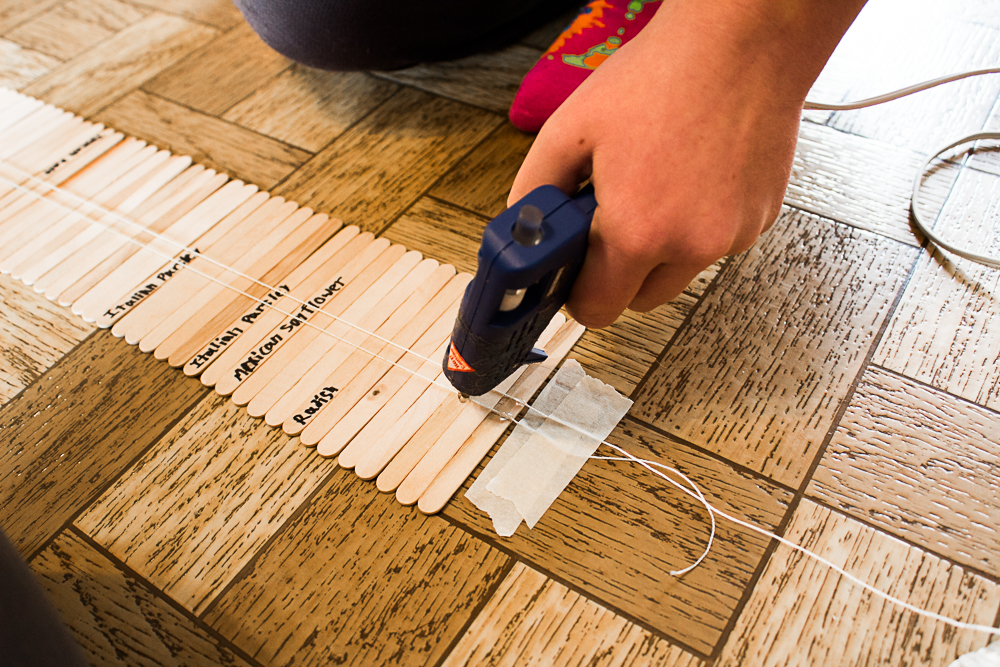Because energy travels in waves, and we can prove it!
This DIY popsicle stick and kite string wave machine is one of many hands-on projects that Will and I are doing as part of the spectroscopy chapters in her astronomy study, but we're both completely obsessed with it. It is really fun, and really fascinating to watch. It both soothes and stimulates (if that's possible? Is that possible? It feels possible!) both of our pattern-loving brains, and we can each entertain ourselves endlessly just by flicking a little popsicle stick and watching the energy cascade down the line.
To make our wave machine, Will and I followed this tutorial:
The real fun, though, is in playing with it!
See the wave move, even though each popsicle stick stays glued to its place? That's how all energy moves, whether it's light, sound, or tsunamis. Beyond just that demonstration, though, there's a lot of visual interest in simply playing with and watching the patterns that emerge through various manipulations of the wave machine. That kind of play and exploration builds intrinsic understanding, which is a very real way to build concrete knowledge and skills. As part of Will's AP Human Geography study, we've been thinking about the ancient stick maps of Micronesia. These maps represented not geography as we conventionally think about it now, but instead a model of the waves around the islands, which is also a very real aspect of geography, but one that most people would find it impossible to comprehend, much less use as a navigation tool. It's likely that sensory experience of the ocean waves provided the intrinsic understanding that made it possible to use the waves in such a way.
It is FASCINATING to see energy travel so concretely, and there's a lot of scope for play and experimentation. I wish I'd made this with the kids when they were young, as I think it would be a picture-perfect hands-on STEM project for upper elementary!
Nevertheless, we have it now, and it hangs in homemade honor from a ceiling hook in our family room. I mean, it's not like we put any effort into tasteful decorating; a popsicle stick wave machine isn't even the oddest homemade thing on display in that room.
And when it's hanging in easy reach, we can still play with it!
Our wave machine, as I mentioned, was a quick little demo for spectroscopy, but understanding how energy travels in waves is also crucial for some of these other studies:
- CALDER AND KINETIC SCULPTURE. Mobile-making and kinetic sculptures of all kinds are a great way to explore physics, as well as to add an art history component to a STEM study. Here's a great resource on the physics of mobiles, and an interesting history of kinetic sculptures, with a lot of images for inspiration.
- SOUND AND HEARING. Vibration is another word for waves, and there are a lot of fun ways to explore how sound travels through space and how our ears work to sense it and our brains work to process it. Use tangible demonstrations like this one with a speaker and salt, this one in which you measure the distance of a signal, and the DIY wave machine, along with a study of the anatomy of the ear.
- TSUNAMIS. Is my kid the only one fascinated by natural disasters? I think we've done deep dives into just about all of them by now! Anyway, use the wave machine along with this TED-Ed video on tsunamis and this DIY diagram of tsunamis to explain the physics behind that particular natural disaster.
This isn't a comprehensive list, of course--it's literally just what's happening to occur to me from our own studies as I'm writing this--and so I'd love, as always, to hear your ideas and suggestions, too. I LOVE multi-disciplinary connections!





No comments:
Post a Comment